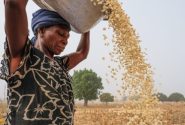
Recent research is painting a more complex picture of the relationships between industries, environment and local people in tropical forests. Jan van der Ploeg/CIFOR
BOGOR, Indonesia (20 December, 2012)_A commonly held view in the developed part of the world is that conservation organisations are doing “good” when offering small-scale development activities to improve local livelihoods of people in remote forested areas, such as those in southeast Cameroon. Similarly, logging concessions are often seen as creating conflicts about resource use or environmental degradation while claiming to enhance local development, with little to show in reality. Many remote areas, such as in parts of Central Africa, are also considered somewhat immune to the havoc of our developed world’s financial cycles and crises, yet suffer from the plundering of their natural resources without receiving much in the way of local benefits.
Two recently published papers by teams of scientists from various institutions (Sayer et al. 2012, Lescuyer et al. 2012) paint a somewhat different and more complex picture than this stereotype, presenting a large shade of grey instead of the general black and white view of the relationships between industries, environment and local peoples in tropical forests.
Lescuyer et al. show that improvement of local livelihoods in Cameroon’s forest areas are mostly dependent on macro-economic drivers such as commodity prices, better road infrastructure and new agricultural techniques. Local people are not as forest-dependent as is usually assumed, and logging concessionaires, whilst not delivering all the promised goods, do not prevent villagers from benefiting from new economic opportunities or from using forest resources, as long as their actions do not affect timber harvesting. Their attitude might best be described as “benevolent” indifference.
In their paper, Sayer et al. demonstrate that foreign direct investment is the key to lifting people in such remote regions out of poverty and, in resisting that investment, conservation organisations may be effectively keeping people in poverty. At the same time, globalisation reaches the poorest of people in the most remote areas and exposes them to the volatility of global markets. For example, when ENRON failed in the USA, a cobalt mine in Lomié, Cameroon, in which it was an investor, closed within months. In the same area, a suspension of logging activities caused by the financial crisis contributed to a deterioration of both biodiversity and livelihood indicators when people lost their jobs and returned to poaching or clearing forests for a living.
Both papers note some negative impacts when forestry activities are not conducted well, but these appear relatively minor compared to the potential beneficial effects of good forestry (for example, when concessions are certified). The contributions to local economies from forestry activities have more impact on the livelihoods of local people than some small eco-development projects promoted by conservation NGOs.
This does not mean these small-scale development activities should be discarded, as they help facilitate dialogue between two very divergent views of nature and the future, and can help build the local empowerment necessary for greater self-determination over future options. But it must also be recognised that the future for both conservation and livelihoods in these remote forest areas will be shaped – at least in part – by properly-designed external investments.
Responsible investments and good forestry practice can play significant roles in creating a better future for these people and forests, and shift investors from benevolent indifference to more proactive, locally-oriented development pathways. This will require better collaboration between conservation, industry, state and community actors at the local level, where all have a voice and prior prejudice is left at the door.
Both papers note that this will not be easy or quick to achieve, but significant progress can be accomplished with very moderate investment, and some first signs are apparent, such as the increased number of logging companies that are certified and attending more seriously to the needs and aspirations of local communities.
We want you to share Forests News content, which is licensed under Creative Commons Attribution-NonCommercial-ShareAlike 4.0 International (CC BY-NC-SA 4.0). This means you are free to redistribute our material for non-commercial purposes. All we ask is that you give Forests News appropriate credit and link to the original Forests News content, indicate if changes were made, and distribute your contributions under the same Creative Commons license. You must notify Forests News if you repost, reprint or reuse our materials by contacting forestsnews@cifor-icraf.org.












